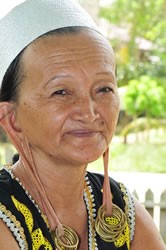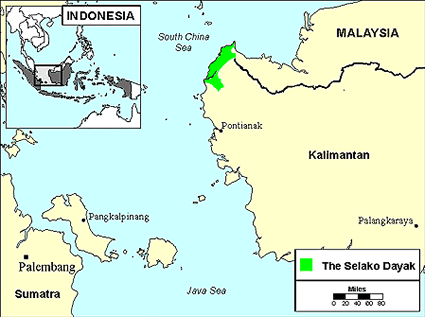The peoples of southern Borneo can be grouped into four main categories: Malay, Migrant, Dayak, and Ot.
The name "Dayak" is a collective term used to describe a number of primarily non-Muslim ethnic and linguistic groups. Those who convert to Islam usually retain their Dayak tongue for a while, but they prefer to be called Malay or Orang laut, rather than Dayak. Living along the banks of the large river systems, the Dayak grow rice using the "slash and burn" technique. They also collect forest products such as rattan, ironwood, rubber, resin and animal skins.
The Dayaks can be further identified as either Land Dayak or Sea Dayak (primarily a European designation to separate the various groups). The majority of Land Dayaks in Indonesia, including the Kendayan, live along tributary streams behind the city of Pontianak.
The Kendayan Dayak are part of the Dayak group of people who live in Sarawak, Malaysia, and Kalimantan, Indonesia. They have their own language, Kendayan, which has incorporated many words from Bahasa, the Indonesian trade language.
The Kendayan Dayak live in an area characterized by rolling hills averaging a few hundred feet above sea level. The land is largely covered with secondary growth and occasionally interrupted by forested limestone peaks.
The Kendayan Dayak make a living mainly by growing rice, but they also engage in fishing and some hunting. In difficult years, wild sago (a kind of palm) is used to supplement their diets. Many households also grow rubber and coffee as cash crops. Because of their need for salt, the Dayak maintain contact with the coastal peoples.
Kendayan Dayak villages are large, relatively permanent, and mostly located near streams. Often, several communities join together to form village clusters. Usually, there is more than one long house in each village, and these may be interconnected by raised walkways.
A common feature of Kendayan Dayak villages is the so-called "headhouse." This house might be better described as a combination men's house, community council house, and ceremonial center. It consists of a large circular room or hall with a high cone-shaped roof. Usually raised on stilts up to 30 feet tall, the headhouse is entered through a trap door in the floor.
The household forms the basic unit of Kendayan Dayak society. Its members live near one another and observe the same taboos and folk beliefs. Descent within the family plays a role in determining land use.
In marriage, the groom's family rarely pays a bride price. Instead, the prospective groom's father presents betel nut (seed of the betel palm) and lime to the girl's father. (This mixture is chewed as a mild stimulant.) After the acceptance of the gift, there is a wedding ceremony attended by close relatives of the couple.
The Kendayan Dayak are ethnic religionists, following their ancient traditions and religions. They know of a supreme being, named Juba, but this is overshadowed by their other beliefs. They worship ancestral spirits, make offerings to stones that are thought to have magical powers and other objects, and pay homage to a war god. They seek protection from ancestral spirits through village ceremonies that combine festivities with religious rituals. Specific foods and activity taboos observed among some of the villages and families are usually inherited from the female line.
However, they also have enough Christians that they can evangelize and disciple every village if they are willing.
In past times, Land Dayaks were abused by bordering Malaysian rulers. They also lost much of their land as a result of headhunting raids of the Sea Dayak. Today, some of the Kendayan Dayak still have a "slave complex" as a result of this long history of exploitation.
Ask the Lord of the harvest to use Kendayan Dayak Christ followers to disciple some in every Dayak village.
Ask the Holy Spirit to grant wisdom and favor to anyone trying to help the Kendayan Dayaks come closer to the only savior.
Ask the Lord to bring forth a vigorous Kendayan Dayak church that will plant churches among Muslims.
Scripture Prayers for the Dayak, Kendayan in Indonesia.
https://en.wikipedia.org/wiki/Kendayan_people
| Profile Source: Joshua Project |












